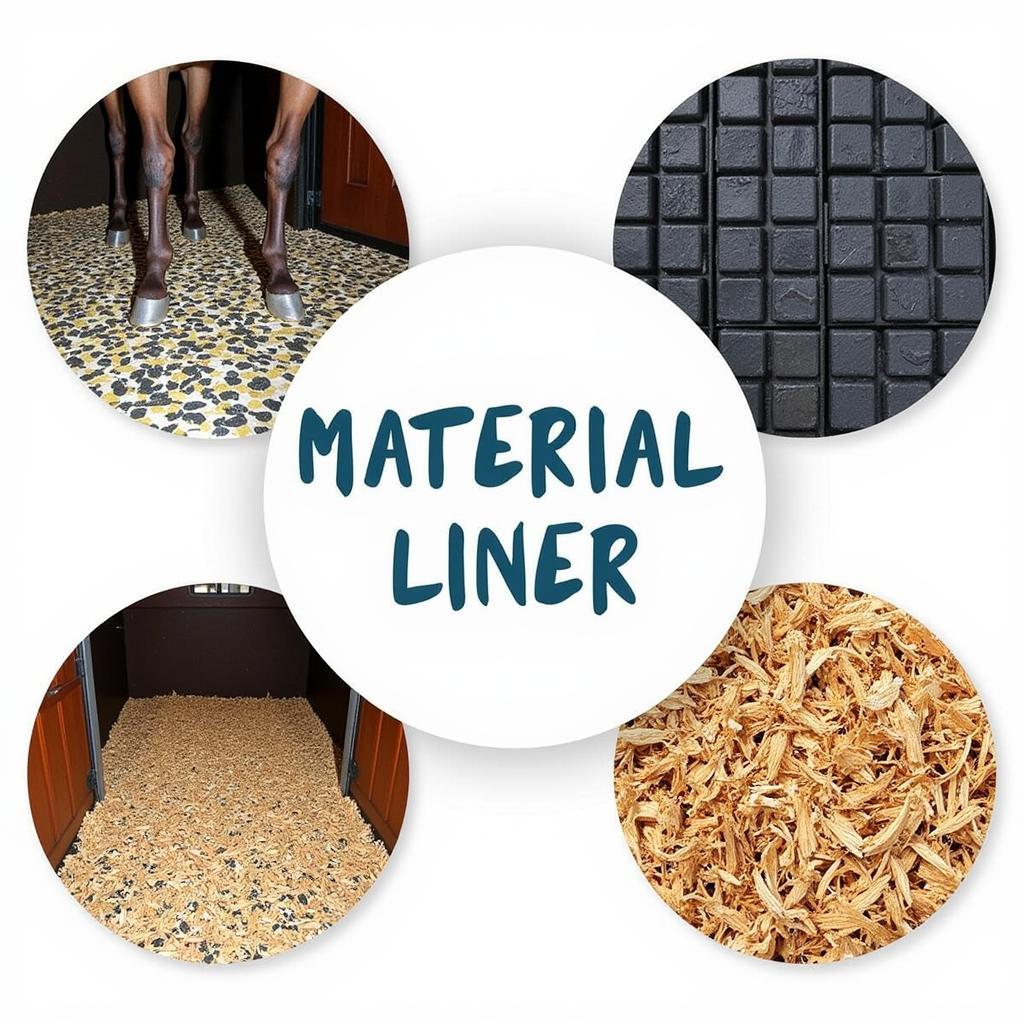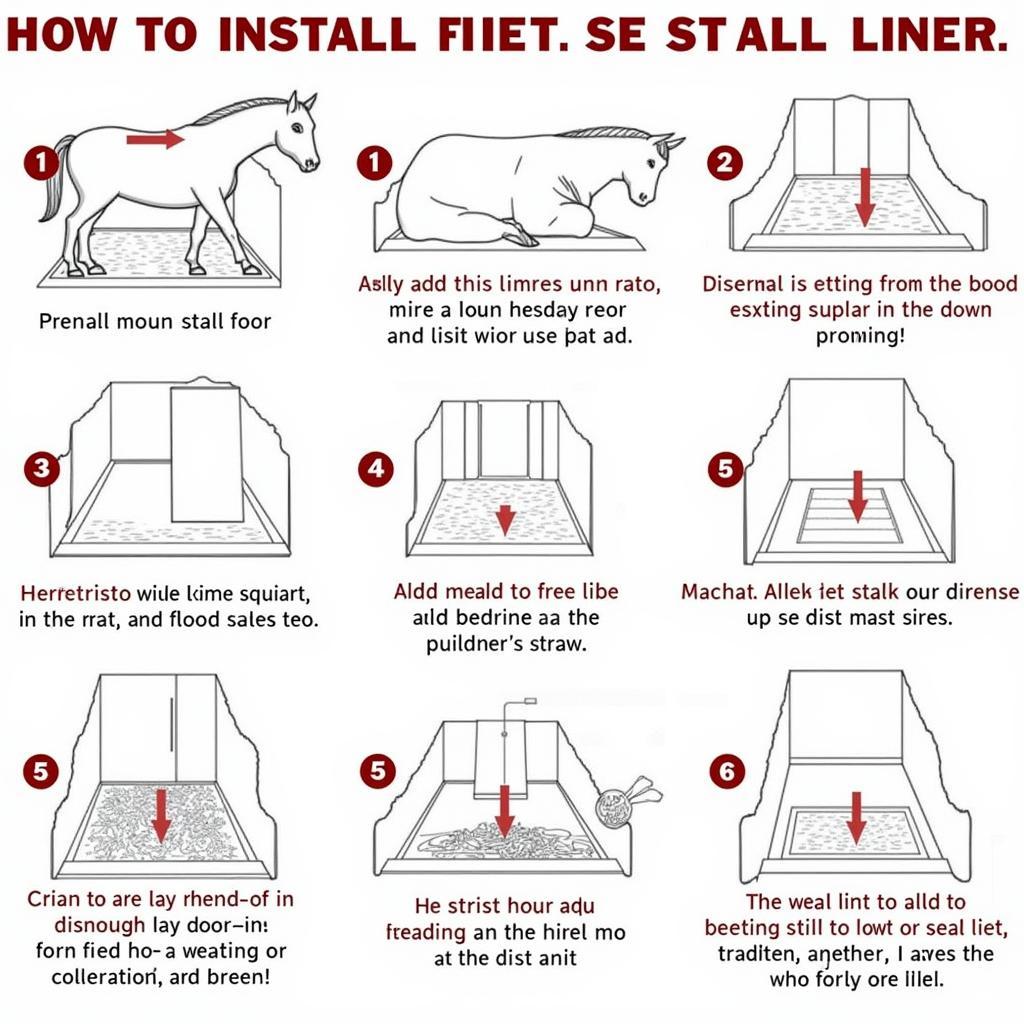Horse Stall Liners are essential for creating a comfortable, hygienic, and safe environment for your equine companion. They play a crucial role in protecting your horse’s health and well-being, while also simplifying stable management. This guide will explore the various types of horse stall liners available, helping you make an informed decision for your horse’s needs.
Understanding the Importance of Horse Stall Liners
A good horse stall liner provides several key benefits. It offers cushioning for your horse’s joints and hooves, reducing the risk of injuries and fatigue. Liners also help absorb urine and moisture, keeping the stall drier and minimizing the growth of bacteria and fungi. This contributes significantly to improved air quality within the stable, reducing respiratory issues. Additionally, liners can protect the stall floor from damage caused by pawing and shifting, prolonging its lifespan.
 Different Types of Horse Stall Liners
Different Types of Horse Stall Liners
Exploring Different Types of Horse Stall Liners
Choosing the right liner depends on your budget, your horse’s specific needs, and your stable management practices. Here are some popular options:
- Rubber Mats: Durable, easy to clean, and provide excellent cushioning. These are a popular choice for many horse owners. They come in various thicknesses and can be installed as interlocking mats or single sheets.
- Interlocking Tiles: Similar to rubber mats, these provide good cushioning and are easy to install and replace individually if damaged.
- Wood Shavings: A traditional bedding material, wood shavings offer good absorbency and can be composted. However, they require frequent replacement and can be dusty.
- Straw: Another traditional option, straw provides good insulation but can be less absorbent than wood shavings and can also be dusty.
- Sand: Sand offers a natural surface and is often preferred by horses. However, it can be difficult to manage and can cause digestive issues if ingested.
Considerations for Choosing the Best Liner
When selecting a horse stall liner, consider factors like your horse’s age, health, and temperament. Older horses or those with joint issues may benefit from thicker, more cushioned liners. Horses prone to allergies might require dust-free options.
 Installing Horse Stall Liners
Installing Horse Stall Liners
Maintaining Your Horse Stall Liners
Regular cleaning and maintenance are crucial to ensure the longevity and effectiveness of your horse stall liners. Remove soiled bedding daily and disinfect the liner regularly. For rubber mats and tiles, scrubbing with a mild detergent and water is usually sufficient.
Why Proper Maintenance is Key
Proper maintenance not only extends the life of your liner but also safeguards your horse’s health. A clean and dry stall is less likely to harbor harmful bacteria and parasites, promoting a healthier environment for your equine companion.
How Do I Know Which Horse Stall Liner is Best for Me?
Consider your horse’s individual needs and your budget. Do you need maximum cushioning, easy maintenance, or a more natural option? Research different materials and consult with other horse owners or professionals for recommendations.
What are the benefits of using a rubber mat stall liner?
Rubber mats offer excellent cushioning, are easy to clean, and are very durable. They are a popular and effective choice for many horse owners. They can also help reduce bedding costs.
“Rubber mats are a game-changer for stall cleanliness and horse comfort,” says Dr. Emily Carter, equine veterinarian. “They provide a supportive surface while minimizing the risk of slips and falls.”
Can I use horse stall liners with other bedding materials?
Yes, many horse owners use liners in conjunction with bedding materials like shavings or straw. The liner provides a base layer of protection and comfort, while the bedding adds absorbency.
“Combining liners with appropriate bedding materials creates the ideal stall environment,” adds stable manager John Miller. “It’s all about maximizing comfort and minimizing health risks for the horses.”
In conclusion, choosing the right horse stall liners is a crucial aspect of horse ownership. By carefully considering your horse’s needs and understanding the various options available, you can create a comfortable, healthy, and safe environment for your equine partner. Remember to prioritize regular cleaning and maintenance to maximize the benefits of your chosen liner.
FAQ
- What is the most durable type of horse stall liner?
- How often should I clean my horse stall liner?
- Can I use horse stall liners on concrete floors?
- Are horse stall liners expensive?
- What are the benefits of using stall liners over traditional bedding?
- What are the different types of horse stall mats?
- How do I install interlocking stall mats?
Other Situations and Questions
- What if my horse chews on the stall liner?
- How do I deal with urine stains on the liner?
- What is the best liner for a horse with allergies?
For further assistance, please contact us at Phone Number: 0772127271, Email: [email protected] or visit us at QGM2+WX2, Vị Trung, Vị Thuỷ, Hậu Giang, Việt Nam. We have a 24/7 customer service team available.